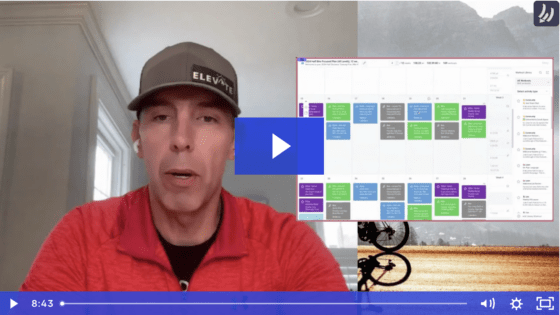Previously in this series we introduced you to the Three Year Plan and discussed the lifecycle of the typical long course triathlete. Then we laid out for you the objectives for Year One of the plan. Today we continue the discussion, moving on to Year Two of the Three Year Plan:
Year Two Objectives:
- Completing a Full Season with Endurance Nation
- Planning for Two “A” Races this Year
- Equipment Upgrades
- Appropriate Volume via Race Camps or Training Camps
- Racing to Your Potential
Objective #1: Completing a Full Season with Endurance Nation
In your first year, we, your Coaches, get you when and how we get you: you join on October, or December, or March with a preset race schedule and we do the best we can with these start date and race schedule conditions. But now, in your second season with EN, hopefully we can have a more comprehensive conversation with you about:
- What races to select this year, in Y2, given the best timing for you?
- Given this Y2 schedule, how to best stack training plans across your year, next season, so that Y2 You crushes Y1 You?
- Given your Y1 and Y2 race schedules, how do we structure the gap between Y1 and Y2 so there is very little gap indeed and we are building vs rebuilding your fitness?
When you end your season in August to early October, for example, this creates the opportunity for a Bike or Run Focus block of training before dropping you into the OutSeason at the end of October. Therefore we are able to take that end-of-season fitness and, before you jump on the Ben and Jerry’s Train, apply it towards improving the weaker of your two sports
^This^ means that we are building your 2015 fitness, for example, directly on top of your 2014 fitness/foundation, rather than you taking significant time off at the end of your ’14 season = detraining = we spend about 8-9wks in the OS just rebuilding your fitness rather than building directly on top of the ’14 fitness you worked so hard to create.
Hopefully you’ve learned how critical, for your long term, make-me-FASTER growth as a triathlete, smart, effective race scheduling is! Our best tools for making you much, much faster are some combination, in priority order, of:
- OutSeason
- Get Faster
- Bike or Run Focus Plan
When you don’t carefully select races, you limit our ability to apply ^these^ tools to the job of making you faster.
Objective #2: Planning for Two “A” Races this Season
Most TeamEN athletes will have two “A” race options in their second season. As a Second Year member you have the training and durability to handle a longer, or “split” season. And having more than one “A” race gives you the chance to significantly improve your race execution.
Step 1: Define Your Racing Path
We highly recommend you split your season into a least two parts:
- Part I: OutSeason, then train for and race Event #1
- Part II: Recover from Event #1. Then transition to our Get Faster block, where we consolidate that fitness and use it to become even faster, before training and racing Event #2
Now, the composition of that OutSeason block on the first half, or what exactly you do in that gap, if there even is one, between Event #1 and Event #2 can vary…as well as what other smaller events you may be doing in route to these bigger events. But the keys are this:
- You are NOT training “for” a race for longer than about 10-16 weeks. In our experience, this is the optimum length of time that most age groupers can and should be focusing on one event without going crazy, burning significant SAUs, etc.
- We keep your training volume as low as we can for as long as we can, so we can keep your head out of this “training for my race” space and we can keep you focused on making yourself much faster through high intensity, low volume, relatively low mental cost training.
Step 2: Submit Your Triathlon Season RoadMap™ Survey
Once you have decided on your race schedule, please begin the Triathlon Season RoadMap (TSR) process. Coach Rich will plan everything out for you and you can discuss it with him in the Macro Forum afterwards.
Objective #3: Equipment Upgrades
While there is no need to spend excessively in your first year, now you have a sense of your commitment to the sport and a better appreciation for your goals. It’s okay to consider upgrades to your equipment as you now know just how important your training and performance is to you, where are your best ROI opportunities, etc.
Swim Upgrades:
After a year of swimming “EN” style, it’s okay to consider joining a Masters swim program if there is one in your area and it fits your life schedule. This program is less about technique, and more about consistency and pushing your swim comfort zone.
Bike Upgrades
A Powermeter – Assuming that your big Year One purchase was a new triathlon bike, then Year Two means looking at upgrading that ride with a powermeter. On the back of all of our TeamEN training and racing kits is:
Work is Speed Entering the Body
A powermeter lets you measure, in real time, the actual work you are doing against the work you should be doing. The result is that your training, and racing, are much, much more efficient and precise than heart rate based methods. We’re not saying that you must have a powermeter. Or even that everyone should have a powermeter. But if you have the funds available, it’s certainly one of the highest rate of return investments you can make in this sport.
Run Upgrades
A GPS Device — If you don’t have one, then a GPS-enabled device is the natural first selection here. Training and racing with pace will ensure you are running both as hard and as easy as our methodology requires.
Objective #4: Appropriate Volume via Race Camp or Training Camp
Our deliberate focus on training Return On Investment (ROI) and the manipulation of training intensity for results isn’t because we hate volume. Rather, we fear the unspecific nature of volume-oriented training. With at least one year of TeamEN training under your belt, you can begin to explore adding miniature volume periods, or “pops,” into your training routine.
Why Include Volume in Micro Doses?
There’s a benefit to training with volume, but it comes with several different costs.
First, it requires a significant time commitment — several sessions longer than three hours a week can quickly add up — so doing this in a camp environment ensures you can get the work in without making compromises elsewhere such as losing sleep, missing work, etc.
Second, the stress of volume is a very different animal than how we ordinarily have you train. The adaptations come very quickly and tend to last significantly longer than the threshold level work we use to built your peak fitness. As such, we can easily integrate volume into the portions of your season where you are building your endurance.
Third, it allows you to push your mental and physical limits in a safe environment, one from which you can easily recover to continue with your scheduled training.
Note: This is more true with cycling than with running — you should always consult with the coaches before adding significant run volume to your plan.
Beyond the “Standard” Volume — Race Camps & Training Camps
Standard volume is written right into the race preparation portions of your Endurance Nation Half Iron and Ironman training plan. This takes the form of Camp Week — a three day junket that consists of a Race Simulation (Day One), a Long Ride (Day Two) and a Long Run (Day Three). Of course, there are tons of other cool things you can do with your fitness, from charity rides and brevets to running relays and Goofy Challenges, to the epic open water swim. Whatever your flavor of volume, we work closely to make sure it fits the overall plan!
A Race-Specific Camp
Triathlon isn’t about racing…it’s about how you drive that fitness vehicle around the course via proven race execution processes. Our focus on Race Execution is what sets Endurance Nation Ironman Training Camps apart from all others; and our Race Specific camps are a crash course in everything you need to know to be ready for race day. Every training camp includes 5-6 hours of instruction and three solid days of course-specific training. By the time you are done, you will know every inch of the course. You will be confident. You will be prepared. And you will know exactly what to do over the final few weeks to get 100% ready for race day!
Objective #5: Racing to Your Potential
With the knowledge you have gained / earned in your First Year, we begin to push the envelope of actual racing means. If the First Year is about setting limits and reasonable expectations, then your Second Year is about lifting the hood and making some modifications for improvements.
Overall: Confirm Nutrition Plan & Execution
One of the hardest race execution elements to master is your nutrition. After your first year inside Endurance Nation you should have a pretty good idea of what does and doesn’t work for you. In your Second Year the goal is to make sure this is bullet proof — you know what works, you know how to modify it for the heat, you know what to do if you start burping, or even fading.
The Bike: A Reduced “Just Riding Along / JRA” Window
Moving into your Second Year means you have a more intuitive sense of pacing as well as a deeper understanding of how important it is to ride as steady as possible. Because of this, you have the room to reduce the time spent “settling in” at the start of the bike.
The standard do-no-harm guidance for iron-distance events is approximately 90 minutes / up to the first 30 miles. For half iron events, the guidance is approximately the first 30 minutes / up to 10 miles. Now that you are in your Second Year, you can effectively cut that time in half, if not in thirds. So your Ironman JRA time is now a maximum of 45 minutes and could be as short as 30 minutes. And the 70.3 JRA time is a maximum of 15 minutes and could be as short as 10 minutes.
The Run: Racing with Three Metrics
By end of your First Year on the Team, and certainly by midway through your Second Year, you will have significant experience training with the intensity metrics of heart rate, pace, and Rate of Perceived Exertion. And you’ll use this deep knowledge to perform better on race day by making veteran-like decisions: “At a heart rate of 145bpm I’m used to seeing 9:15 pace and it feeling like about a 6 on a scale of 1-10. But now, at mile 14 of IMXX, I’m seeing 150bpm at 9:30 pace but it feels like like a 7. In addition, it’s 85 degrees, my stomach feels like this and my hydration state is that. What should I do?
This is how the Second Year veteran races, with an intimate knowledge of their body gained through their extensive experience with these three metrics.





Leave a Reply